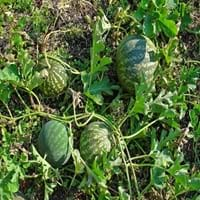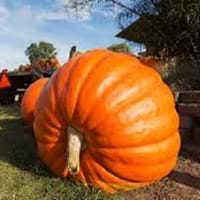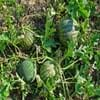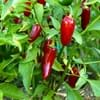Origin
Hybrid origin, Africa, Southern Africa
South America
Types
Not Available
Not Available
Habitat
along watercourse, Grassland
gardens, Moist Soils
USDA Hardiness Zone
10-12
Not Available
Sunset Zone
A3, H1, H2, 1a, 1b, 2a, 2b, 3a, 3b, 4, 5, 6, 7, 8, 9, 10, 11, 12, 13, 14, 15, 16, 17, 18, 19, 20, 21, 22, 23, 24
A1, A2, A3, H1, H2, 1a, 1b, 2a, 2b, 3a, 3b, 4, 5, 6, 7, 8, 9, 10, 11, 12, 13, 14, 15, 16, 17, 18, 19, 20, 21, 22, 23, 24
Habit
Prostrate/Trailing
Vining/Climbing
Flower Color
Yellow
Yellow, Gold
Flower Color Modifier
Bicolor
Bicolor
Fruit Color
Green, Crimson, Dark Green
Yellow, Orange
Leaf Color in Spring
Light Green
Green, Light Green
Leaf Color in Summer
Green, Gray Green
Green, Dark Green
Leaf Color in Fall
Green, Gray Green
Green, Dark Green
Leaf Color in Winter
Not Available
Not Available
Leaf Shape
Irregular
Heart-shaped
Plant Season
Summer, Fall
Summer, Fall
Sunlight
Full Sun
Full Sun
Growth Rate
Very Fast
Very Fast
The pH of Soil
Neutral
Neutral
Soil Drainage
Well drained
Well drained
Bloom Time
Indeterminate
Indeterminate
Tolerances
Drought
Drought
Where to Plant?
Container, Ground
Ground
How to Plant?
Seedlings, Transplanting
Seedlings
Plant Maintenance
High
Medium
Watering Requirements
Requires consistently moist soil, Requires regular watering, Requires watering in the growing season, Water Deeply
Keep the ground moist but not water-logged, Requires consistently moist soil, Requires regular watering, Requires watering in the growing season, Water in the early morning hours
In Summer
Lots of watering
Lots of watering
In Spring
Moderate
Moderate
In Winter
Average Water
Average Water
Soil Drainage Capacity
Well drained
Well drained
Sun Exposure
Full Sun
Full Sun
Pruning
Remove damaged leaves, Remove dead leaves, Remove dead or diseased plant parts
Prune after flowering
Fertilizers
fertilize in growing season, Nitrogen, Potassium
Apply 5-10-5 amounts, Nitrogen, Phosphorous, Potassium
Pests and Diseases
brown-spot needle blight, Cutworms, Downy mildew, Flea beetle, Flea Beetles, Fungal Diseases, fungus, Fusarium wilt, Powdery mildew, Red blotch
Red blotch
Plant Tolerance
Drought, Salt
Drought
Flower Petal Number
Single
Single
Foliage Texture
Coarse
Coarse
Foliage Sheen
Matte
Matte
Attracts
Bees, Insects, Squirrels
Beetles, Bugs
Allergy
Stomach pain, Throat itching
Asthma, breathing problems, Itchiness, Nasal Congestion, Swelling, Swelling in the face
Aesthetic Uses
Ground Cover
Not Used For Aesthetic Purpose
Beauty Benefits
Not Available
Good for skin and hair, Not Available, Skin cleanser, Skin Problems
Environmental Uses
Air purification, Food for animals, Food for birds, Food for insects, Versatility
Air purification
Medicinal Uses
High blood pressure, Nutrients
Anemia, Antibacterial, anti-cancer, cholesterol-lowering, Fertility, High blood pressure, Immunity, Liver problems, Prevention of convulsion, Regulates Blood Sugar
Part of Plant Used
Fruits
Fruits, Leaves, Seeds
Other Uses
Used As Food, Used for its medicinal properties, Used in making beverages
Used As Food, Used as Ornamental plant, Used for its medicinal properties, Used in salads
Used As Indoor Plant
No
No
Used As Outdoor Plant
Yes
Yes
Garden Design
Edible, Fruit / Fruit Tree, Herb / Vegetable, Tropical, Vine
Edible, Herb / Vegetable
Botanical Name
CITRULLUS lanatus 'Crimson Sweet'
CUCURBITA maxima 'Atlantic Giant'
Common Name
Crimson Sweet Watermelon, Watermelon
Atlantic Giant Pumpkin, Pumpkin
In German
Wassermelone
Kürbis
In French
Citrullus lanatus
Citrouille
In Spanish
Citrullus lanatus
Calabaza
In Greek
καρπούζι
Κολοκύθι
In Portuguese
Citrullus lanatus
Abóbora
In Polish
Citrullus lanatus
Dynia
In Latin
Citrullus lanatus
cucurbita
Phylum
Embryophyta
Magnoliophyta
Class
Magnoliopsida
Magnoliopsida
Order
Cucurbitales
Violales
Family
Cucurbitaceae
Cucurbitaceae
Genus
Citrullus
Cucurbita
Clade
Angiosperms, Eudicots, Rosids
Angiosperms, Eudicots, Rosids
Tribe
Benincaseae
Cucurbiteae
Subfamily
Cucurbitoideae
Cucurbitoideae
Number of Species
Not Available
Not Available
Season and Care of Citrullus Lanatus and Giant Pumpkin
Season and care of Citrullus Lanatus and Giant Pumpkin is important to know. While considering everything about Citrullus Lanatus and Giant Pumpkin Care, growing season is an essential factor. Citrullus Lanatus season is Summer and Fall and Giant Pumpkin season is Summer and Fall. The type of soil for Citrullus Lanatus is Loam and for Giant Pumpkin is Loam while the PH of soil for Citrullus Lanatus is Neutral and for Giant Pumpkin is Neutral.
Citrullus Lanatus and Giant Pumpkin Physical Information
Citrullus Lanatus and Giant Pumpkin physical information is very important for comparison. Citrullus Lanatus height is 15.20 cm and width 240.00 cm whereas Giant Pumpkin height is 30.00 cm and width 500.00 cm. The color specification of Citrullus Lanatus and Giant Pumpkin are as follows:
Citrullus Lanatus flower color: Yellow
Citrullus Lanatus leaf color: Light Green
Giant Pumpkin flower color: Yellow and Gold
- Giant Pumpkin leaf color: Green, Light Green
Care of Citrullus Lanatus and Giant Pumpkin
Care of Citrullus Lanatus and Giant Pumpkin include pruning, fertilizers, watering etc. Citrullus Lanatus pruning is done Remove damaged leaves, Remove dead leaves and Remove dead or diseased plant parts and Giant Pumpkin pruning is done Prune after flowering. In summer Citrullus Lanatus needs Lots of watering and in winter, it needs Average Water. Whereas, in summer Giant Pumpkin needs Lots of watering and in winter, it needs Average Water.





